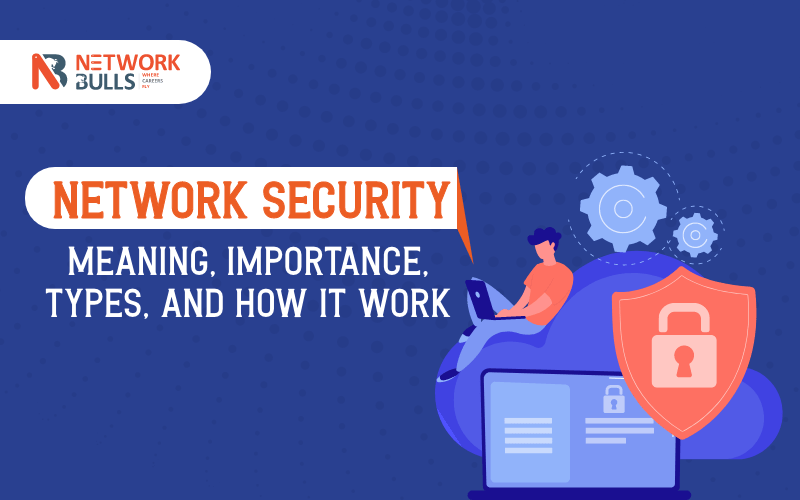Network Security: Meaning, Importance, Types, And How It Works

Network security in which both hardware and software technologies are used primarily aims at ensuring protection of your network, foiling data breaches and intrusions into the network and other threats.
It mainly involves:
-
Application of both hardware and software
-
Configurations concerning the network in use
-
Accessibility
-
Overall or wide spectrum threat protection including intrusion into the network in question
-
Integration of your network whether LAN or WAN
How does it work?
The basic function of network security is to control the access to your system from undesired quarters that might try to intrude on it. It works by constantly monitoring your network and also mapping it to identify any attempt to intrude or actual intrusion.
Network security works in the following manner:
-
Restricting access or access control: It secures the network from intrusion and insertion of malware. Thus it fortifies the access and controls it.
-
Defends Network through multiple layers: Network security functions with the help of a combination of multiple layers of defences at the edge and in the network. Such defending layers will foil any attempt of intrusion or planting of malware.
-
Use of Security Key: As part of security to the network, physical, digital, signature or biometric data are used as keys to stop an unauthorized user from connecting or intruding into a particular network. Basically, a network security key is a wireless network password or a Wi-Fi password.
-
Safeguarding Network Infrastructure: It works to protect the integrity of network infrastructure, resources and traffic to foil attacks into the system of network laid out with protective layers. It works so at two levels: at the perimeter and inside the network.
-
Theft Mitigation: Some quarters may try to sabotage and intrude into your network whether it is a home network or a business network. Network security works to foil any attempt to steal data from your network. For this, you can use one or more wireless routers as most home and office users implement high-speed internet connection for their networks.
Different Types of network security
To protect the network, different types of technologies are used in network security. These technological measures are used to maintain the integrity of an organization’s infrastructure and also protect the usability of the company or organization’s network by foiling all intrusions. This is done using the following types of network security:
-
Firewall: Controlling both incoming and outgoing traffic and data on a given network, Firewall excludes all intrusions, application-layer attacks and block malware. A Firewall is basically a barrier between the authorized users of a network and unknown or unauthorized users from outside the network. You can use software, hardware or ultra-sophisticated next-gen UTM (Unified Threat Management) devices developed by the Cisco Corporation.
-
Email Security: This is most needed in your network as scam email is the most common threat posed to your network. It can breach your security as your personal data cancan be stolen through such fake emails. Such emails are used for phishing and push malware into your network.
-
Anti-Virus & Anti-Malware Software: Advanced malware protection software can ensure network security to a great extent. Such software can effectively fight against viruses, malware, spyware, ransomware, worms and Trojans. This method scans malware soon after its entry, detects files already affected by such a virus upon finding anomalies, remove malware and fixes damages.
-
Network segmentation: This is one of the methods to secure your network. Network segmentation software applied in a company or an organization can define boundaries between network segments and puts network traffic into various classifications thus mitigating the intrusion or data theft risks.
-
Access Control: This is a mechanism under which your network can identify or recognize each user and each device. In other words, access to your network is regulated very strictly to the extent of denying access by unknown and unauthorized entities. This is done with the help of Identity and Access Management (IAM) devices. The IAM can identify the user.
-
Application Security: Under this network security type, hardware, software and processes are used to plug all holes into the network to foil any intrusion. This is a technical process of developing, adding and testing security features within the periphery of applications to stop the network’s vulnerability to various threats.
-
Behavioral Analytics: It envisages spotting abnormal network behaviour and deviation from the set technical norms. Upon finding it, you can fix the network by shooting the troubles.
-
Data loss prevention: To stop DLP (Data Loss Prevention), measures are taken using the latest technologies to stop the leak of data and sensitive information outside the network. Under DLP, both best practice and technology are combined to prevent leakage of regulated data like personally identifiable information (PII) and compliance-related data: HIPAA, SOX and PCI DSS.
 Download PDF Network Security: Meaning, Importance, Types, And How It Works
Download PDF Network Security: Meaning, Importance, Types, And How It Works -
Intrusion prevention systems (IPS): The IPS detects and scans network traffic and blocks attacks and intrusion. Cisco has developed NGIPS or Next Generation IPS to mitigate network threats. The NGIPS can block malicious activity, track the progression of suspect files and find out malware across the network.
-
Mobile device management: Mobile devices are growingly becoming vulnerable to different sorts of hacking, intrusion and all other forms of cybercrimes. Even mobile apps are also being targeted. You can implement it by configuring their connections to keep network traffic private.
-
Web security: Under this technology, the web use of a company within a given network can be monitored and block web-based threats. Subsequently, access can be denied to any unauthorized entity to protect the web gateway on-site in the cloud.
-
Application of SIEM: SIEM stands for Security information and event management. SIEM products collect and combine information that your security staff needs to identify and respond to threats. You can introduce physical and virtual appliances and also use server software.
-
Wireless security: This is a network security measure to prevent a security breach.
In Conclusion
In view of digitization and the application of the internet in the day-to-day functions of human beings and business platforms, it has become necessary to implement the regime of network security to maintain the security of your network whether LAN or WAN.
Unauthorized intrusions often cause hazards to the protection of proprietary information of a company, an office or an individual. Network security effectively acts as an anti-virus and anti-malware shield. It helps a unified regime and streamlines the operational system.
- RECOMMENDED POSTS
-
Trending (0)

-
Network Bulls Placements (53)

-
CCIE (101)

-
CCNP (32)

-
CCNA (40)

-
Awards (14)

-
Network Bulls Reviews (53)

-
Informational Articles (74)

-
Technical Articles (26)

-
CCIE Success Stories (40)

-
Summer Training Courses (5)

-
CCIE Security Version 5 (34)

-
CCIE Data Center (19)

-
MCSE (3)

-
Industrial Training (10)

-
Microsoft Certification (3)

-
Ask NB (7)

-
Network Bulls Offers (6)

-
Best Institute for CCIE Training in India (118)

-
CCIE Training Courses (78)

-
DHCP (2)

-
Webinars (6)

-
Training (128)





















